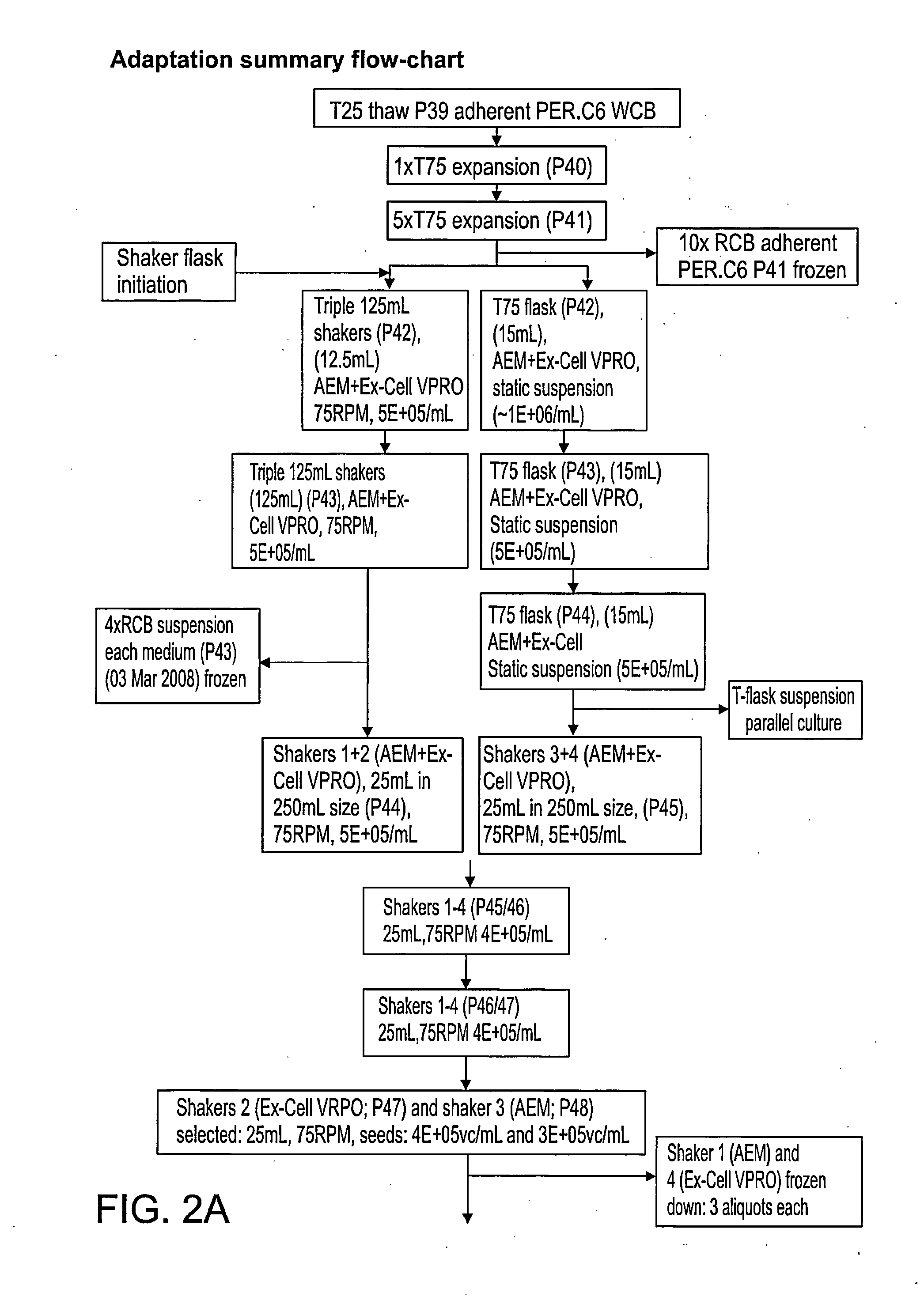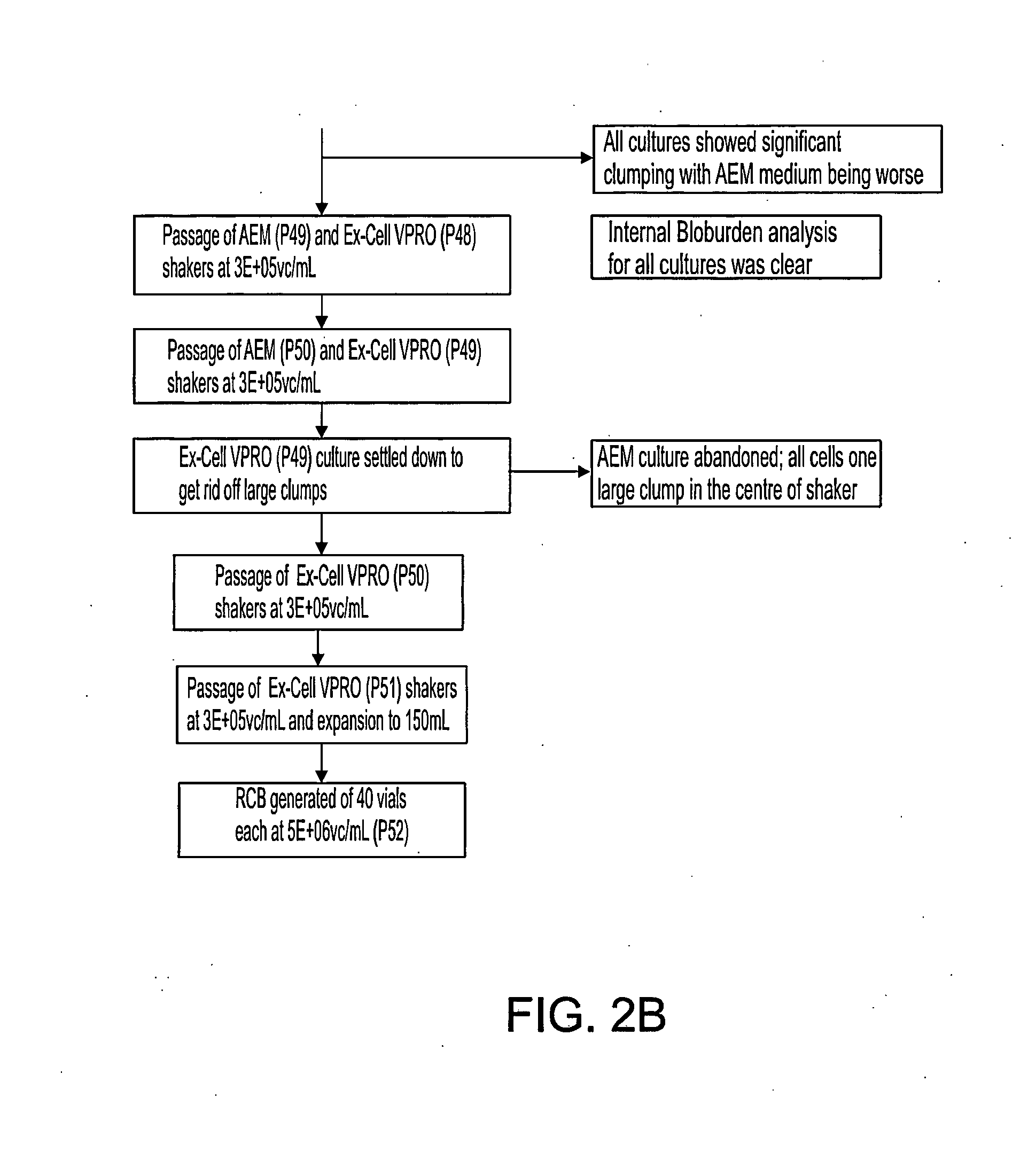Methods of Producing Adenovirus Vectors and Viral Preparations Generated Thereby
a technology of adenovirus and vector, applied in the field of methods, can solve the problems of inefficiency of vascular-specific promoters and hampered transduction targeting of ecs by gene therapy approaches, and achieve the effect of reducing angiogenesis and reducing angiogenesis
- Summary
- Abstract
- Description
- Claims
- Application Information
AI Technical Summary
Benefits of technology
Problems solved by technology
Method used
Image
Examples
example 1
Generation of Adherent PER.C6 WCB (Working Cell Bank)
[0485]The working cell bank (WCB) was propagated under GMP conditions to create the VBL WCB WCBP6001. A vial of the Crucell WCB (Lot# B127-006, p36), was thawed and expanded through serial passages to P(passage)39. These cells were harvested at 70% confluence and stored as a working cell bank in 1 ml aliquots in liquid N2. The cells are of human origin, viable, negative for bacteria and fungi, negative for mycoplasma, no exhibition of CPE, No HA, No HAD, as determined by in vitro assay for Adventitious viruses, negative for in apparent viruses (using suckling mice, adult mice, guinea pigs and embryonated eggs).
example 2
Generation of Suspended (Non Adherent) PER.C6 MCB (Master Cell Bank)
[0486]Whilst it is possible to produce ppe-1-3x-Fasc using adherent cell culture approach, it is preferable to use suspension cell cultures where possible, due to the scale limitation of adherent cell cultures and the need for serum-containing media.
[0487]FIGS. 2A-B are flow charts that summarize the adaptation steps of adherent WCB to the RCB in suspension. Suspended MCB is generated from the RCB, as outilined in Table 7, below.
TABLE 7Preparation of Master Cell Bank (Procedure)Cell ThawingThaw 1 ampoule of 1 ml RCB PER.C6 cells at 37° C. in a water bath.Slowly add 9 ml of pre-warmed growth medium to the thawed cells. Centrifuge at 210 g at 22° C. for 5minutes. Discard the supernatant; add 10 ml of growth mediumSeed cells in a T75 cm2 flask. Incubate at 37 ± 2° C. for 3 days.↓Cell ExpansionFirst Passage: Incubate 4-T75 cm2 flasks at 37 ± 2° C. for 3 days at a density of 3.0 × 105 viablecells / ml.Second passage: Pool ...
example 3
Construction of the PPE1-3X-Fas-c Chimera
[0488]pWE.Ad.AfAfIII-rITRsp Backbone Cosmid, is a 40.5 kb cosmid, purchased from Crucell. This backbone contains most of the genome of adenovirus type 5, as well as partial homology to the pAdAdpt5 adaptor plasmid, which enables recombination.
[0489]The E1 early transcriptional unit was deleted from the backbone plasmid (pWE.Ad.Afiii-rITRsp). The cosmid was digested with PacI restriction enzyme deleting the pWE25 and the Amp resistance selection marker site (see FIG. 10).
[0490]The Adaptor Plasmid—The pAdApt plasmid, 6121 bp, contains sequences of the Ad5, CMV promoter, MCS, and SV40 polyA (see FIG. 11).
[0491]The plasmid was digested at the SnaB1 and EcoR1 sites deleting the CMV promoter. These sites were used to insert the PPE and Fas-c fragment.
[0492]Gene Insert
[0493]Restricted expression of the transgene to those tissues that endogenously recognize the promoter PPE-1—the angiogenic endothelial cells is based in the PPE-1-3x, a modifie versio...
PUM
| Property | Measurement | Unit |
|---|---|---|
| volume | aaaaa | aaaaa |
| volume | aaaaa | aaaaa |
| volume | aaaaa | aaaaa |
Abstract
Description
Claims
Application Information
 Login to View More
Login to View More - R&D
- Intellectual Property
- Life Sciences
- Materials
- Tech Scout
- Unparalleled Data Quality
- Higher Quality Content
- 60% Fewer Hallucinations
Browse by: Latest US Patents, China's latest patents, Technical Efficacy Thesaurus, Application Domain, Technology Topic, Popular Technical Reports.
© 2025 PatSnap. All rights reserved.Legal|Privacy policy|Modern Slavery Act Transparency Statement|Sitemap|About US| Contact US: help@patsnap.com



